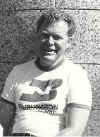|


| |
Searching for the Great Northern in Tumwater Canyon


by
Fr. Dale Peterka
Father
Dale Peterka is a former President of the Great Northern Railway Historical
Society and now handles Publication Development for the
GNRHS.
Also
visit the
Tumwater Dam
story for additional information.
----------------------
Coming up in December 2000 is the hundredth anniversary of the opening of the first Cascade Tunnel. Located on the mainline of the Great Northern Railway in the Cascade Mountains of Washington, the tunnel allowed trains to bypass the summit and to proceed directly from Cascade Tunnel Station, on the east side of Stevens Pass, to Wellington, Washington, on the west side. The original 1893 line over the pass was so steep that a series of switchbacks had been necessary. Trains sawed back and forth until they reached the 4000-foot summit. In times of good weather, the line was a major headache, causing traffic backups and delays. In winter, snow removal on the pass was a continuing nightmare.
Cascade Tunnel, opened in December 1900, allowed the switchback route over the pass to be abandoned, an improvement hailed by the railroad and its customers alike.
But the tunnel brought new troubles. The bore was made on a slight grade. This allowed good drainage, but also meant that eastbound trains
were working uphill, filling the tunnel with lots of thick, black smoke. Soon stories of crew and passengers being sickened by the fumes began to
accumulate. After several incidents that nearly claimed some lives, the Great Northern decided to solve the smoke problem by pulling the trains
through the tunnel with electric locomotives. In 1909, trolley wire was hung in the tunnel, on the approach tracks and in the yard at both ends,
and four boxcab "motors" were purchased from General Electric.

The
stucco-covered brick powerhouse and surge tank were built about a mile below the
dam in Tumwater Canyon with a large pipeline carrying water under pressure from
the reservoir to the tank. Three turbines drove generators that converted
water power to electricity.
Some miles east of the tunnel, the railroad built a powerhouse on the
Wenatchee River in Tumwater Canyon and installed three hydroelectric
generators to power the new locomotives. To drive the generators, a dam
was built about a mile upstream, and a large diameter pipeline was
installed to carry the water under pressure to the powerplant. A steel
water tank on a hundred foot tower was erected next to the facility to
protect the pipeline and the generators from surges in water pressure.
After some early problems, the electrical system and its locomotives
served the Great Northern for seventeen years. In 1927, an improved new
system was built. The electrified zone was extended at both ends: west to
Skykomish and east to Wenatchee, and a new mainline was built through
Chumstick Canyon, bypassing the Tumwater Canyon line. The old powerplant
was sold. The roadbed in the canyon became part of the newly built Cascade Highway, U.S. 2.
One of the interesting features of the old powerplant was the pipeline.
Following the primitive technology of the day, it was made from wood! The
pipe was made from wooden staves, much like a classic wooden barrel. But
instead of bands, the wooden body was wrapped with a continuous length of
heavy steel wire to hold the staves in place and to resist water pressure. Eight feet in diameter, the pipe, which was called a "penstock" in the old documents, followed the river for over a mile from the dam down to the surge tank and to the
powerplant.

The
original steel bridge that carried the pipeline across the river to the
powerhouse survives today, as does the bottom half of the pipeline which serves
as a walkway.
The pipe ran along the bank of the Wenatchee River. Ideally, it should
have been buried next to the mainline to protect it from freezing and from accidents, but there was no room for it alongside the train track in the narrow canyon. Instead, it followed a path on the other side of the river, and a steel bridge was built to carry it across to the powerplant, which was built trackside. Old photos show also a residence on the site for the plant operators.

The original pipeline was made from wood staves. It is clear from this
photo that at least part was replaced with half-inch steel pipe sometime
later. The remains of the pipe in the nearby tunnel are wood stave.
There is no evidence that the tunnel was bypassed, so at least part of the wood
stave section was in use until the plant was closed. In 1927, the power
plant was sold to the utility supplying electricity to the Great Northern for
the new system.
Today, there is a parking lot on the site for the use of hikers and fishermen. Part of the powerhouse foundation remains, as well as foundation piers for the surge tank. The bridge over the Wenatchee survives. Hikers can cross on the remains of the penstock! The original wooden pipe had been replaced by a steel pipe, at least at this point, and the bottom half --eight feet in diameter-- serves as a walkway across the bridge.
The pathway on which the penstock once rested is now an access trail for
a pole line. Hikers can walk the mile or so upstream to the dam. At one
point, remains of an aqueduct can be seen (is that the right word?).
Resembling a small snowshed, it served to carry a mountain stream over the pipeline. A fish ladder makes the stream above the dam accessible to
salmon and trout. Behind the dam, Lake Jolanda parallels the highway for
another mile or so, a beautiful survivor of a bygone era.
The spookiest part of the hiking trail is the nearly obscured tunnel
that the railroad built at one point to carry the pipeline through a rock
outcropping. Inside the tunnel is what's left of a section of the old
wooden penstock! The staves have all rotted away, but the great coils of
steel wire remain, like the remains of some giant accordion hiding in the
darkness!

At
one point, the railroad was forced to avoid a rock outcropping by running the
wooden penstock through a tunnel. Today rock falls have hidden the tunnel
portal, but with a bit of scrambling, it can be found. The remains of the
wire wrap are still in place, and the tunnel is still accessible for foolish
explorers! 
Another
view of the pipeline under construction.
The walk from the bridge to the dam is an easy one, following the rapid Wenatchee River with the high cliffs of Tumwater Canyon on both sides. You walk leisurely, enjoying the moment, but your thoughts go back to the days when passenger trains made their way up this canyon. In winter, steam-powered rotary plows labored to keep the line open. Huge wooden snowsheds kept the slides off the track at the narrowest parts. The smell of coal smoke mingled with the scent of pine needles. And brave little Ten-wheelers labored up the grade past Drury, Winton, Merritt, and Berne to Cascade Tunnel. From there, it was downhill all the way to Seattle!

An ancient postcard photo showing the early Great Northern mainline
through Tumwater Canyon. The roadbed is right at water level and there is
little or no ballast supporting the track. There was clearly no room on
this side of the river for the later pipeline.
  |
